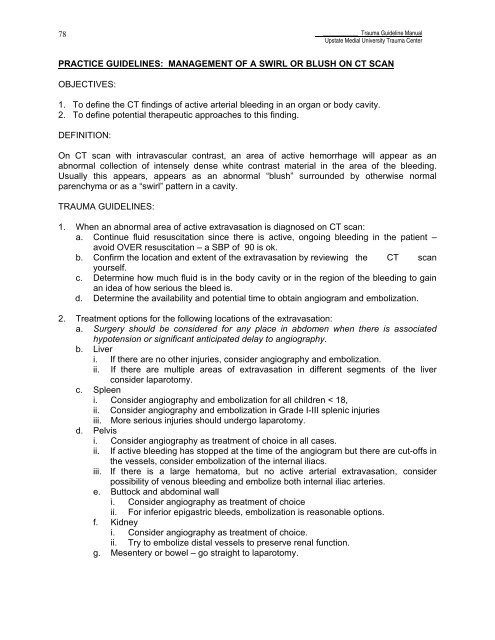Trauma Guideline Manual - SUNY Upstate Medical University
Trauma Guideline Manual - SUNY Upstate Medical University
Trauma Guideline Manual - SUNY Upstate Medical University
You also want an ePaper? Increase the reach of your titles
YUMPU automatically turns print PDFs into web optimized ePapers that Google loves.
78____________ <strong>Trauma</strong> <strong>Guideline</strong> <strong>Manual</strong><strong>Upstate</strong> Medial <strong>University</strong> <strong>Trauma</strong> CenterPRACTICE GUIDELINES: MANAGEMENT OF A SWIRL OR BLUSH ON CT SCANOBJECTIVES:1. To define the CT findings of active arterial bleeding in an organ or body cavity.2. To define potential therapeutic approaches to this finding.DEFINITION:On CT scan with intravascular contrast, an area of active hemorrhage will appear as anabnormal collection of intensely dense white contrast material in the area of the bleeding.Usually this appears, appears as an abnormal “blush” surrounded by otherwise normalparenchyma or as a “swirl” pattern in a cavity.TRAUMA GUIDELINES:1. When an abnormal area of active extravasation is diagnosed on CT scan:a. Continue fluid resuscitation since there is active, ongoing bleeding in the patient –avoid OVER resuscitation – a SBP of 90 is ok.b. Confirm the location and extent of the extravasation by reviewing the CT scanyourself.c. Determine how much fluid is in the body cavity or in the region of the bleeding to gainan idea of how serious the bleed is.d. Determine the availability and potential time to obtain angiogram and embolization.2. Treatment options for the following locations of the extravasation:a. Surgery should be considered for any place in abdomen when there is associatedhypotension or significant anticipated delay to angiography.b. Liveri. If there are no other injuries, consider angiography and embolization.ii. If there are multiple areas of extravasation in different segments of the liverconsider laparotomy.c. Spleeni. Consider angiography and embolization for all children < 18,ii. Consider angiography and embolization in Grade I-III splenic injuriesiii. More serious injuries should undergo laparotomy.d. Pelvisi. Consider angiography as treatment of choice in all cases.ii.If active bleeding has stopped at the time of the angiogram but there are cut-offs inthe vessels, consider embolization of the internal iliacs.iii. If there is a large hematoma, but no active arterial extravasation, considerpossibility of venous bleeding and embolize both internal iliac arteries.e. Buttock and abdominal walli. Consider angiography as treatment of choiceii. For inferior epigastric bleeds, embolization is reasonable options.f. Kidneyi. Consider angiography as treatment of choice.ii. Try to embolize distal vessels to preserve renal function.g. Mesentery or bowel – go straight to laparotomy.
















